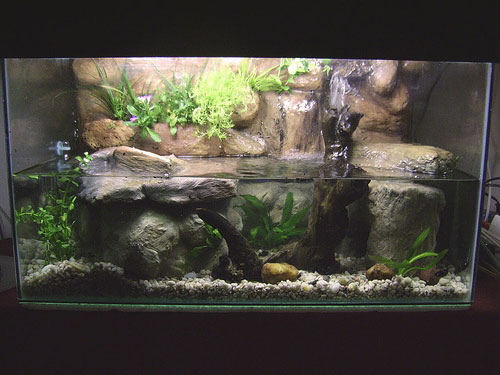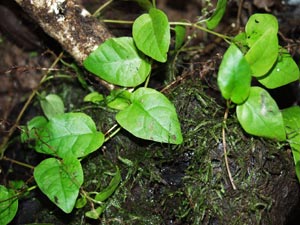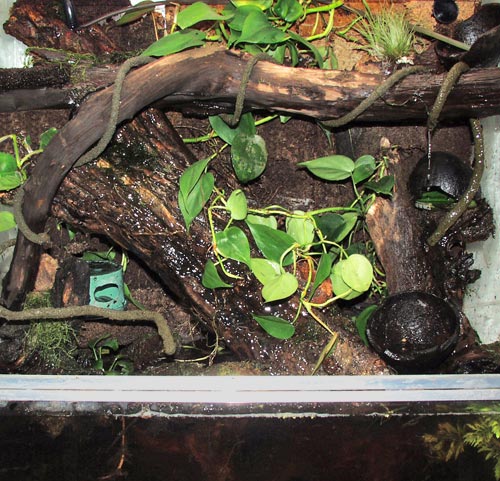


Ripariums are closely related to paludariums, but typically have a greater focus on water rather than land. Tank water is circulated, usually pumped over some form of planted waterfall; often rich in mosses, semi-aquatic marsh plants, and even fully terrestrial species. This keeps the water clean and aerated, whilst providing water and nutrients to plants living in and around the waterfall. Plants can be grown with roots trailing down into the water. The waterfall itself is a great home for nitrifying bacteria, and biological filters the tank. Ripariums usually have less land than a typical paludarium, and the plants are often bigger and stronger than in a typical paludarium. Other ripariums may use a rain installation to mimic tropical environments for moisture loving frogs.
The tank approaches a mini-ecosystem with the only real inputs being fish food and light, which eventually convert to plant growth, that will eventually require pruning. This kind of circulation of nutrients replicates the processes that occur in nature, and in a lightly stocked (in terms of animals) and heavily planted riparium, the water will barely need changing (though it will require topping up, due to evaporation).

If water purification is an important reason for choosing a riparium, the use of quick growing species can greatly help. Plants such as Pothos, or Devils' Ivy (Epipremnum sp.) grow rapidly without even being planted. Simply locate a cutting near (or in) the water source and roots will quickly grow down into the water, sucking up nitrates and other impurities, and providing refuge for fish and nitrifying bacteria. Pothos can be propagated, simply by taking cuttings and placing the stem end in a volume of water. In a fish-only riparium, an open top can let such plants grow out of the tank, for a very attractive display indeed. Plants can quite literally be balanced over the tank edge. Roots grow down into the water, whilst foliage overhang the external walls of the tank, perhaps growing towards sunlight from a nearby window.
Another quick growing species is the Creeping Fig (Ficus pumila). These plants are readily available, in home and garden stores - in the houseplant section, and are typically very inexpensive. The more nutrients they absorb, the quicker they will grow. Great for providing quick coverage / shade in the enclosure, or to create a living wall, but remember to cut them back, especially if they start to overtake smaller slower-growing specimen plants.
Sometimes a riparium is the most suitable enclosure for a specific species to exhibit their natural behaviour. Fish such as Archer fish (Toxotes species) can hunt insects on overhanging leaves. And the fascinating species in the Rivulus genus (a type of killifish) enjoy jumping out of the water and laying on a moist bank... perhaps looking for food, perhaps.. well who knows? But they are always ready to jump back in again, as soon as someone approaches the tank.

The tank to the right shows a newly set up riparium. It consists eight inches deep reservoir of water, and a structure of mopani wood, cork bark and artificial vines. Water is pumped using a standard aquarium pump (always with a sponge filter over the inlet to avoid accidents) from the main body up a tube conveniently hidden behind the woodwork, allowing water to trickle downwards. A few coconut shells have been placed to catch water and create tiny pools at various levels. Although not yet properly planted, cuttings of Pothos and small amounts of Java Moss have been added, and whilst not yet established will soon grow into the space. The wetter areas becoming coated with carpets of moss, and the whole structure tied together by Pothos roots, which grow down into the water, sucking out all the nutrients they require. In good light, (frankly even in average light), nutrients are converted to plant growth. Significant amounts of foliage have to be removed every few weeks.
A tank like this is ideal for housing small fish and amphibians. Ground dwelling frog species are less suitable as there is little actual ground, though, especially once full of plant growth, there is plenty of space for leaf dwellers. Of course reducing the water level and adding further stones or wood into the water (creating numerous islands) can increase the suitability for other species. This tank went on to house several species from Colombia, a dart frog Dendrobates truncatus and several species of Rivulus killifish.
This wonderful 3 foot wide tank has a waterproof glass bottom, and adequate front window ventilation to keep the front glass clear. Although marketed as a Terrarium, it works as the perfect Paludarium. Front-opening doors, and removeable top for easy access and effective maintenance. Available in a wide range of sizes: with a larger surface area for ground/water dwelling species, or taller for leaf dwellers. Suitable for just about any paludarium inhabitant.
The top is equipped with closable inlets on both sides - this allows access for wires and tubing without offering an escape route for paludarium animals or the tiny invertebrates with which they are being fed. Suitable for powering Heat Wave rocks, waterfalls, filters and sensors, or injecting water through misting systems, external canister filters, etc.
All in all a great enclosure, providing a perfect environment for plants and animals, yet easy maintenance for the paludarium keeper. Available from Amazon and other good pet stores.